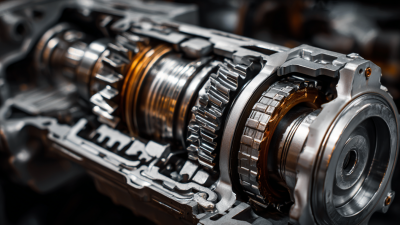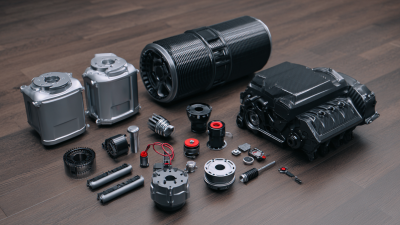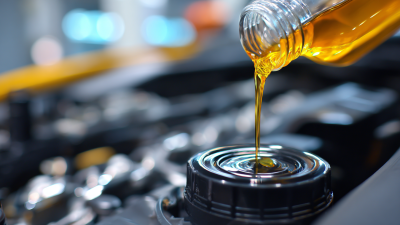5 Essential Tips for Choosing Quality Transmission Parts for Your Vehicle
When it comes to maintaining the performance and longevity of your vehicle, the quality of transmission parts plays a critical role. According to industry reports, poorly manufactured transmission components can lead to a staggering 25% increase in repair costs and significantly reduce the lifespan of your vehicle's transmission system. Furthermore, statistics show that up to 60% of all automobile failures are attributed to transmission issues, highlighting the importance of investing in high-quality parts. With the ever-growing market for transmission components, it’s essential for vehicle owners to be informed and discerning when selecting parts to ensure reliability and efficiency. This blog will provide you with five essential tips for choosing quality transmission parts that not only enhance performance but also safeguard your investment in the long run.

Factors to Consider When Selecting Transmission Parts for Optimal Performance
 When it comes to selecting transmission parts for your vehicle, optimal performance hinges on several key factors. First and foremost, compatibility is essential. Ensuring that the parts you choose match your vehicle's make and model prevents future malfunctions and ensures smooth operation. Not all transmissions are created equal, so conducting thorough research beforehand is crucial.
When it comes to selecting transmission parts for your vehicle, optimal performance hinges on several key factors. First and foremost, compatibility is essential. Ensuring that the parts you choose match your vehicle's make and model prevents future malfunctions and ensures smooth operation. Not all transmissions are created equal, so conducting thorough research beforehand is crucial.
Quality is another vital aspect. Look for parts that meet industry standards and have a reputation for durability. Opt for well-reviewed parts from trusted suppliers. This not only enhances your vehicle's performance but can also save you money in the long run by reducing the need for frequent replacements.
Additionally, consider the intended use of your vehicle. If you frequently drive in demanding conditions, you might need more robust parts designed to withstand higher stresses. Taking into account your driving habits will guide you towards parts that provide the best value and performance for your specific needs. These tips can dramatically impact your vehicle's reliability and efficiency.
Understanding OEM vs. Aftermarket Parts: Making the Right Choice
When it comes to choosing transmission parts for your vehicle, understanding the difference between OEM (Original Equipment Manufacturer) and aftermarket parts is crucial. OEM parts are made by the vehicle's manufacturer and ensure the highest level of compatibility and performance. They often come with a warranty and are designed to meet specific quality standards. On the other hand, aftermarket parts are produced by third-party companies and can vary widely in quality and price. While they may offer savings, it’s essential to do your research to ensure you're not sacrificing quality for cost.
A key tip is to always check the warranty when purchasing transmission parts. OEM parts usually come with a comprehensive warranty, giving you peace of mind in case of defects or issues. Another important consideration is to read reviews and gather recommendations for aftermarket parts. Look for brands with a solid reputation in the industry to ensure you're selecting reliable transmission components. Lastly, consulting with a professional mechanic can provide valuable insights into which option may be best suited for your vehicle's needs, helping you make an informed decision.
The Importance of Compatibility: Ensuring Parts Fit Your Vehicle
When it comes to selecting transmission parts for your vehicle, compatibility is paramount. Each vehicle is designed with specific components that work harmoniously together, and using parts that don’t fit can lead to significant issues down the line. It is crucial to reference your vehicle's make and model when shopping for transmission components. Many parts may look similar, but even slight variances can affect performance and longevity.
Another essential aspect of compatibility is the manufacturer’s specifications. Genuine parts from the original manufacturer are often the best choice, as they are designed to meet the exact requirements of your vehicle. However, high-quality aftermarket parts can also provide a good fit, as long as they adhere to the same specifications. Always verify that any part you’re considering is intended for your specific vehicle. This diligence not only ensures a proper fit but can also save you time and money by preventing future repairs and replacements that could arise from using incompatible parts.
Recognizing Quality: Key Features to Look for in Transmission Components
When choosing quality transmission parts for your vehicle, recognizing the key features is essential to ensure optimal performance and longevity. First, consider the material used in the components. High-quality transmission parts are often made from durable materials such as hardened steel or aluminum alloys, which can withstand high stress and heat. A report from the Automotive Components Manufacturers Association emphasizes that using top-grade materials can prevent premature wear and reduce maintenance costs over time.
Another critical factor to look for is the precision of manufacturing. Components that are machined to exact specifications (with tolerances as tight as 0.001 inches) help maintain the overall efficiency of the transmission system. Investing in parts that meet OEM standards ensures compatibility and reliability, as highlighted in various industry studies showing that deviations in part quality can lead to up to 30% increase in energy losses in transmission efficiency.
Lastly, pay attention to warranty and after-sales support offered by the manufacturers. A robust warranty indicates confidence in product quality and can protect your investment. Be sure to choose suppliers that provide comprehensive customer service and technical support, as this can make a significant difference in your experience of maintaining your vehicle’s performance over the years.
Cost vs. Quality: How to Balance Budget and Reliability in Your Purchase
When it comes to choosing transmission parts for your vehicle, the dilemma of cost versus quality is a crucial factor that many car owners face. While it might be tempting to go for the cheapest option available, it’s important to remember that in the long run, quality parts can save you money on repairs and maintenance. To strike the right balance between budget and reliability, consider the durability and compatibility of the parts you select. Investing a little more upfront in a high-quality component can lead to enhanced performance and longevity of your vehicle.
One essential tip is to conduct thorough research on brands and their reputations. Look for manufacturers that are known for producing reliable transmission parts, and consider reading customer reviews to gauge others' experiences. Additionally, purchasing parts from authorized dealers ensures that you are getting genuine products that meet the required standards.
Another vital aspect is to evaluate the warranty offered with the transmission parts. A solid warranty is a reflection of a manufacturer’s confidence in their product. Parts backed by a good warranty often signify better quality and reliability. Be sure to weigh these factors against your budget, and remember that sometimes spending a bit more can lead to better peace of mind and vehicle performance in the long haul.

Related Posts
-

How to Optimize Your Vehicle's Performance with Quality Transmission Auto Parts
-

Quality Triumphs in Global Markets Unveiling Best Auto Spare Products from China
-

A Comprehensive Guide to Selecting the Best Motor Parts Based on Application and Features
-

7 Key Reasons Your Engine Coolant Choice Can Save You Money
-

Innovations in Engine Components Shaping the Future of Automotive Technology in 2025
-

Unlocking Efficiency: The Advantages of High-Quality Valve Bodies for Global Buyers